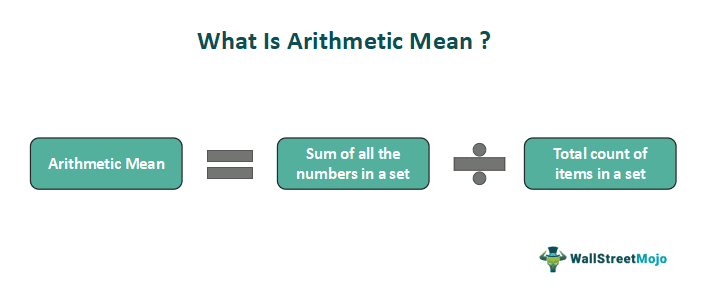Table Of Contents
What does Arithmetic Mean?
Arithmetic mean, commonly used in statistics, is the average of the numerical values set and is calculated by first calculating the sum of numbers in the set and then dividing the resultant by the count of those numbers.
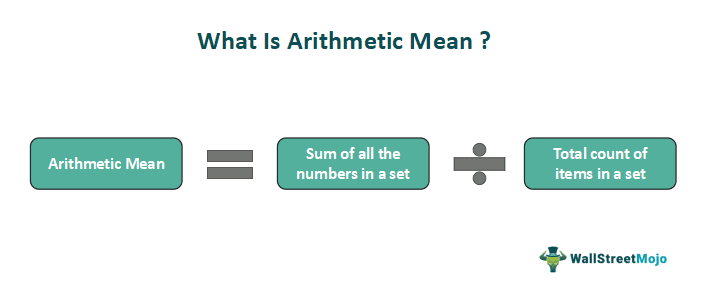
Arithmetic mean shows the central tendency and it is used to summarize the samples obtained from a set or population. It is utilized for stock price valuations from time to time. It, however, doesn’t help in calculating the average value for correlated values.
Arithmetic Mean Explained
Arithmetic mean helps find out the average or mean of the items or numbers in a set. It is one of the few mean-measuring methods that finance industries use, the rest being the geometric mean, harmonic mean, etc. It is obtained when the sum of the items in a set or series is divided by the number of items in the same set.
This mean can either be a simple or weighted average arithmetic mean. It helps to summarize the observations from the population.
Characteristics
The properties of arithmetic mean must be studied to understand the traits that it carries. This helps assess to what extent the results are reliable. Below is a list of features of this mathematical process:
- It gives a generalized result.
- There is no point in finding out the extremes, when the result considered is an average figure.
- Its calculation is simple and comprehensive.
- When the deviations of the numbers or items in the set are added, the result is always zero.
- When users replace the items in the set with the mean and the substitutions are added, the resultant is equal to the result obtained when the individual items or numbers in the set are added.
Formula
The formula is as below:
Arithmetic Mean = x1 + x2 + x3 +……+ xn / n
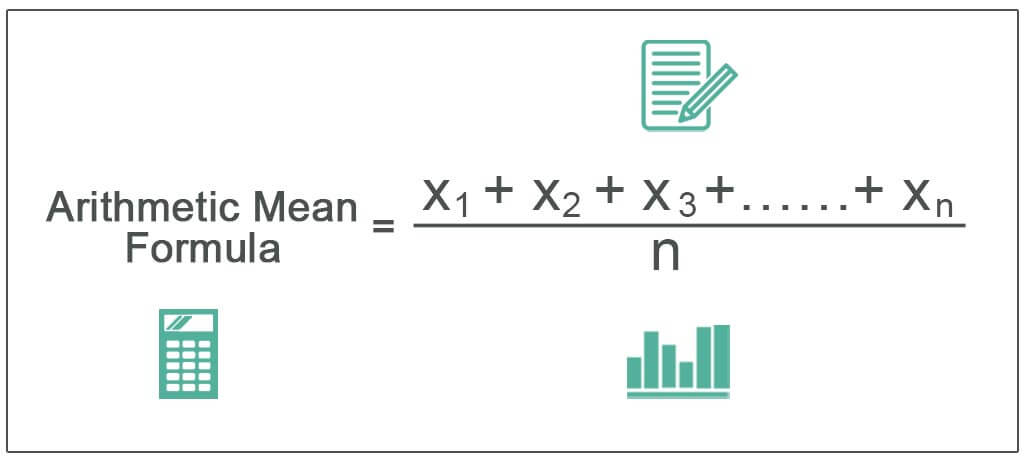
Where,
- x1, x2, x3, xn are the observations
- n is the number of observations
Alternatively, one can symbolically write it as shown below:

In the above equation, the symbol ∑ known as sigma. It implies the summation of the values.
How To Calculate?
To calculate the arithmetic mean, a series of steps is followed. Let us have a look at them:
- Step 1: Calculate the sum of all the observations.
- x1 + x2 + x3 +…….+ xn
- Step 2: Record the total count of the items for which the mean is to be obtained (taken as n)
- Arithmetic Mean = x1+x2+x3+................+xn/n
- Alternatively, the arithmetic mean formula in symbolic terms is as below:

Examples
Let us consider the following examples to understand the arithmetic mean definition better along with its calculation aspects:
Example #1
There are five observations. These are 56, 44, 20, 50, 80. Find their arithmetic mean.
Solution
- Here, the observations are 56, 44, 20, 50, 80.
- n = 5
Therefore, the calculation is as follows,
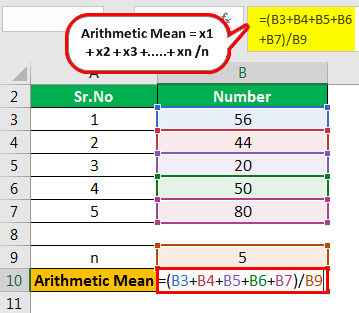
- =56+44+20+50+80/5
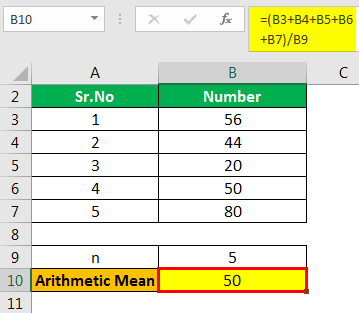
Example #2
Franklin Inc. is a manufacturing concern with ten workers. There are negotiations between the management of Franklin Inc. and its trade union regarding wages. For this purpose, the CEO of Franklin Inc. wants to calculate the company's arithmetic mean of workers' salaries. The following table gives the wages along with the names of the workers.
| Name of the Worker | Wages ($) |
|---|---|
| Jeffery Gates | 100 |
| George Clinton | 120 |
| Thomas Smith | 250 |
| Kamala Sanders | 90 |
| Steve Roosevelt | 110 |
| Martha Smith | 40 |
| Clara Truman | 50 |
| Nicholas Obama | 150 |
| Michael Carlin | 70 |
| Arnold Smith | 100 |
| Number of Observations (n) | 10 |
Calculate the arithmetic mean of wages for the CEO.
Solution
Therefore, the calculation is as follows:
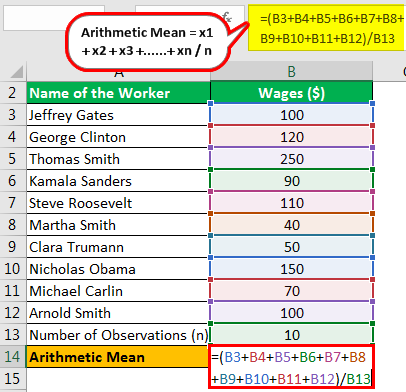
- =(100+120+250+90+110+40+50+150+70+100+10)/10
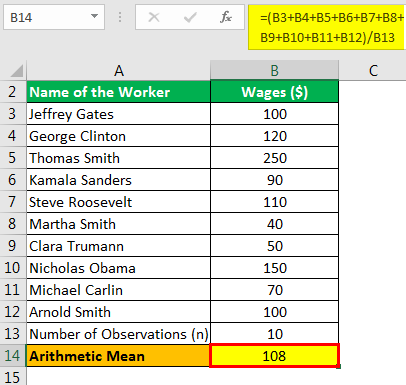
Example #3
The school principal calls two teachers to his office – one teaches Division A, and the other teaches Division B. Both of them claim that their teaching methods are superior. The principal decides that the division, which has a higher arithmetic mean of marks, will have a better teacher. These are the marks of 7 students each studying in the two divisions.
| Sr. No | Division A | Division B |
|---|---|---|
| Student 1 | 56 | 70 |
| Student 2 | 60 | 65 |
| Student 3 | 56 | 60 |
| Student 4 | 64 | 65 |
| Student 5 | 70 | 75 |
| Student 6 | 55 | 55 |
| Student 7 | 50 | 65 |
Find out which division has higher arithmetic mean.
Solution
Division A
The calculation is as follows:
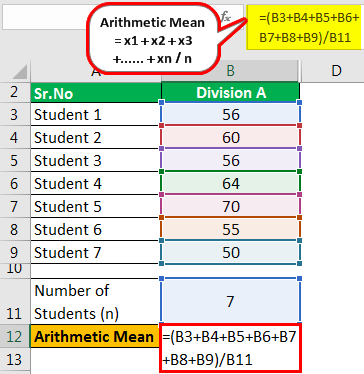
- =(56+60+56+64+70+55+50)/7
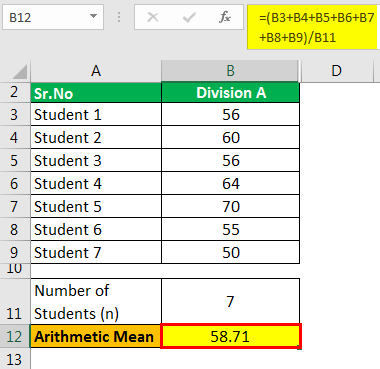
- =58.71 marks
Division B
The calculation is as follows:
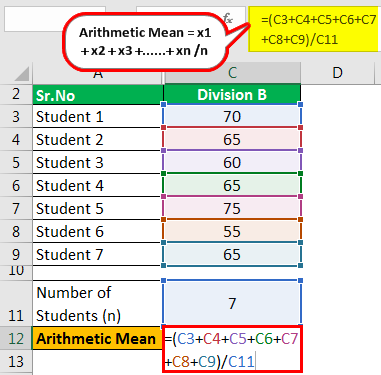
- =(70+65+60+65+75+55+65)/7
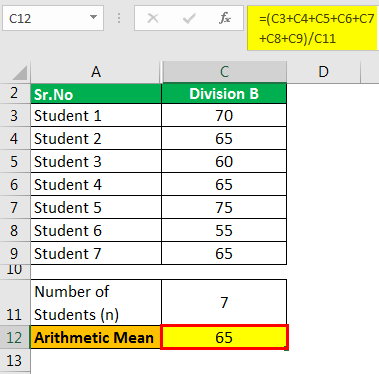
- = 65 marks
The arithmetic mean of Division A is 58.71 marks, and for Division B is 65 marks (higher)
Arithmetic Mean in Excel
There is company Grandsoft Inc. which is listed on the stock exchanges. Different analysts have given their target price of the stock. Calculate the arithmetic mean of the stock prices.
| Analyst | Target Price |
|---|---|
| A | 1000 |
| B | 1200 |
| C | 900 |
| D | 900 |
| E | 1500 |
| F | 750 |
| G | 750 |
Solution
In Excel, there is an in-built formula to calculate the mean.
Step #1 - Select a blank cell and type =AVERAGE(B2:B8)
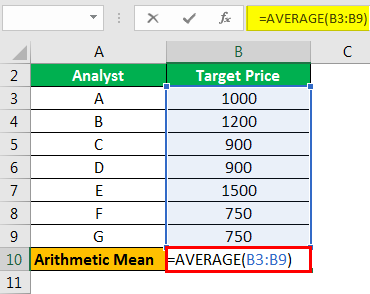
Step #2 - Press “Enter” to get the answer
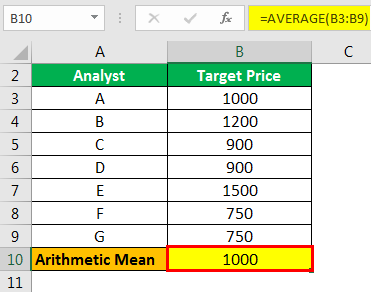
Uses
The arithmetic mean is one of the most important statistics and is most commonly used as the most popular measure of central tendency. It is straightforward to calculate and does not require knowledge of high-end statistics. One may use it when all observations in the data set are equally important. A weighted mean is used if some statements are more important than others.
Merits & Demerits
Arithmetic mean is a mathematical calculation method that is widely used in multiple sectors. There are many reasons that make users consider this method of computation to find out an average number for further observations and assessments. Let us have a look at a list of advantages of using this method:
- Though there are a number of items in a set, each item or number has its own importance in this method of calculation. This is because each value contributes to the computation of the mean.
- It is a simple, straightforward, and comprehended form of calculating an average value.
- Even if the numbers or items are repetitive in a set, there is not much difference in the resultant figure. Hence, the values can be relied on.
- It is widely used in central tendency measures and for comparison purposes.
Undoubtedly, there are a number of advantages to this form of computation. However, it does have a few demerits as well. Let us also have a look at them:
- Fluctuations in sampling affect the method adversely.
- One item or number in the series can have a huge impact on the results. Any additions or deletions in the set affect the mean value majorly.
- Frequent distributions are expected for a more effective and reliable result.
Arithmetic Mean vs Geometric Mean
Arithmetic mean and geometric mean are the two types of mean computation methods that are considered in the financial sector. However, which one of them is used depends on the purpose for which the calculation needs to be done.
Some of the differences between the two are as follows:
- The former is the method used when the raw values are taken to calculate an average value. On the other hand, the geometric mean is used when the values are correlated.
- For compounding effects to be considered, the geometric mean is considered, while the arithmetic mean doesn’t seem helpful in such calculations.
For historical performances to be measured and assessed, the geometric mean is used. On the contrary, the arithmetic mean is more into measuring or assessing future performances.
